TOYOTA SEQUOIA 2009 2.G Owners Manual
Manufacturer: TOYOTA, Model Year: 2009, Model line: SEQUOIA, Model: TOYOTA SEQUOIA 2009 2.GPages: 612
Page 241 of 612
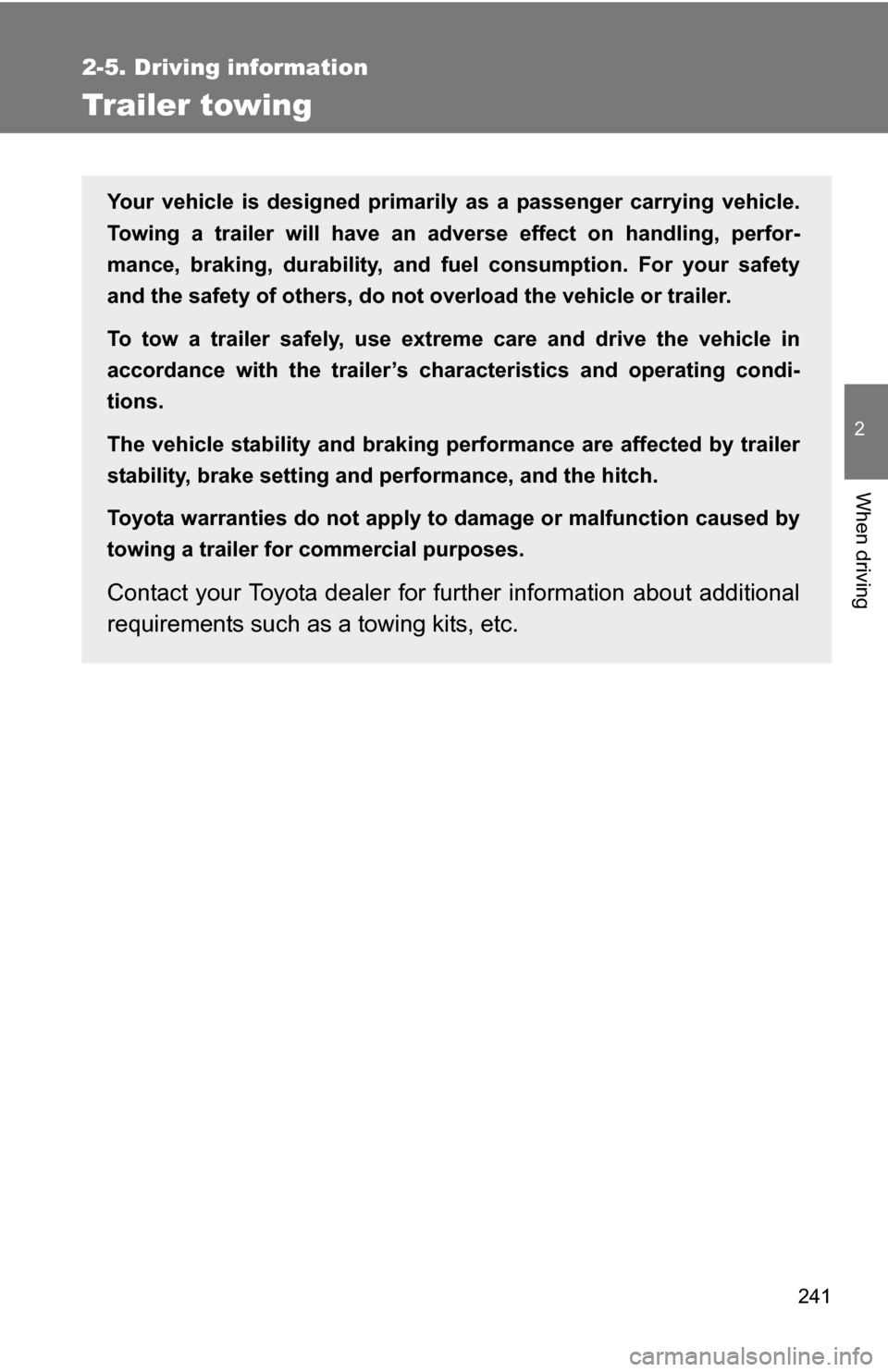
241
2-5. Driving information
2
When driving
Trailer towing
Your vehicle is designed primarily as a passenger carrying vehicle.
Towing a trailer will have an adverse effect on handling, perfor-
mance, braking, durability, and fuel consumption. For your safety
and the safety of others , do not overload the vehicle or trailer.
To tow a trailer safely, use extreme care and drive the vehicle in
accordance with the trailer’s char acteristics and operating condi-
tions.
The vehicle stability and braking performance are affected by trailer
stability, brake setting and performance, and the hitch.
Toyota warranties do not apply to damage or malfunction caused by
towing a trailer for commercial purposes.
Contact your Toyota dealer for fu rther information about additional
requirements such as a towing kits, etc.
Page 242 of 612
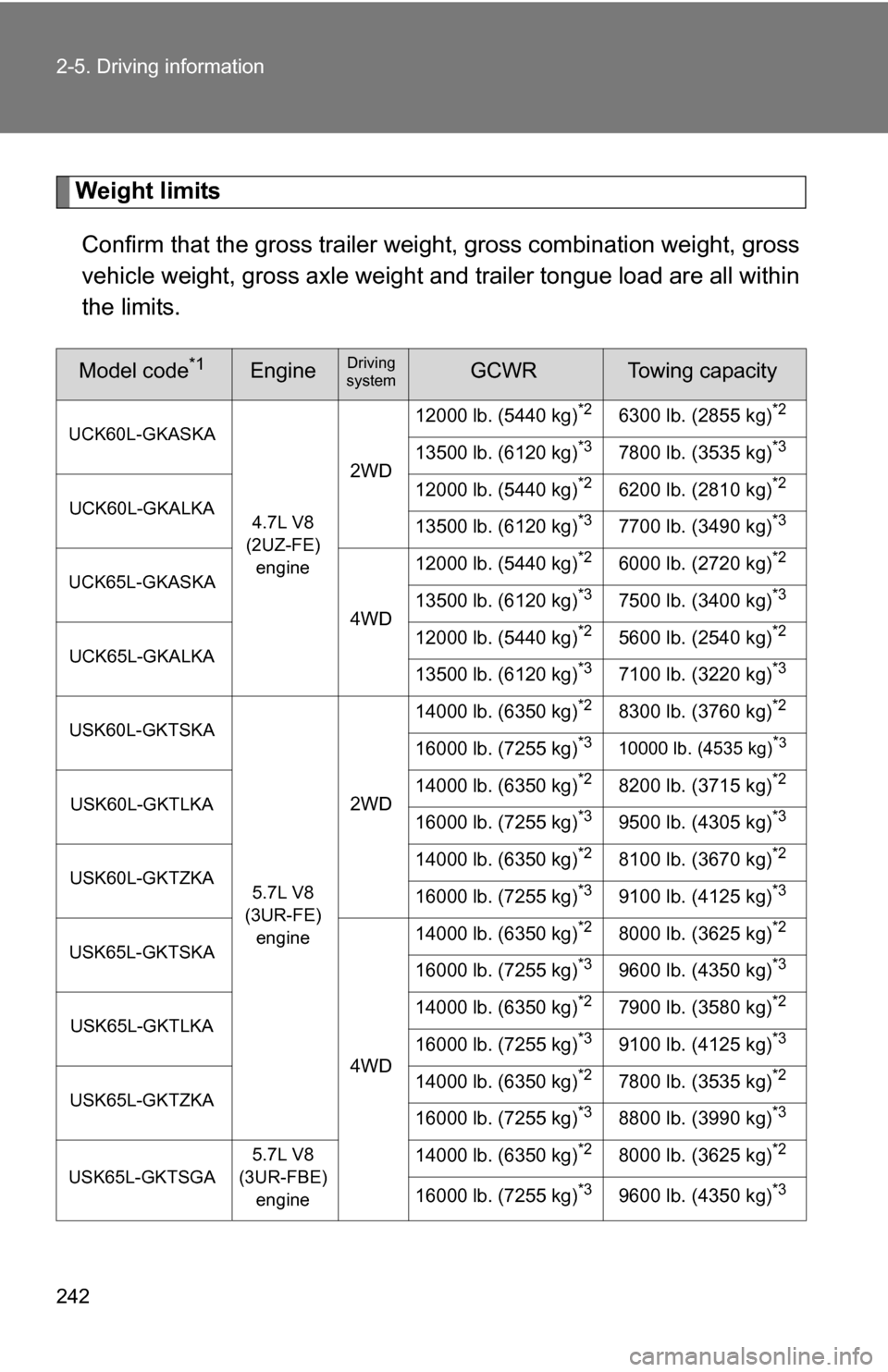
242 2-5. Driving information
Weight limitsConfirm that the gross trailer weight, gross combination weight, gross
vehicle weight, gross axle weight and trailer tongue load are all within
the limits.
Model code*1EngineDriving
systemGCWRTowing capacity
UCK60L-GKASKA
4.7L V8
(2UZ-FE) engine
2WD 12000 lb. (5440 kg)
*26300 lb. (2855 kg)*2
13500 lb. (6120 kg)*37800 lb. (3535 kg)*3
UCK60L-GKALKA12000 lb. (5440 kg)*26200 lb. (2810 kg)*2
13500 lb. (6120 kg)*37700 lb. (3490 kg)*3
UCK65L-GKASKA
4WD12000 lb. (5440 kg)
*26000 lb. (2720 kg)*2
13500 lb. (6120 kg)*37500 lb. (3400 kg)*3
UCK65L-GKALKA12000 lb. (5440 kg)*25600 lb. (2540 kg)*2
13500 lb. (6120 kg)*37100 lb. (3220 kg)*3
USK60L-GKTSKA
5.7L V8
(3UR-FE) engine
2WD 14000 lb. (6350 kg)
*28300 lb. (3760 kg)*2
16000 lb. (7255 kg)*310000 lb. (4535 kg)*3
USK60L-GKTLKA14000 lb. (6350 kg)*28200 lb. (3715 kg)*2
16000 lb. (7255 kg)*39500 lb. (4305 kg)*3
USK60L-GKTZKA14000 lb. (6350 kg)*28100 lb. (3670 kg)*2
16000 lb. (7255 kg)*39100 lb. (4125 kg)*3
USK65L-GKTSKA
4WD14000 lb. (6350 kg)
*28000 lb. (3625 kg)*2
16000 lb. (7255 kg)*39600 lb. (4350 kg)*3
USK65L-GKTLKA14000 lb. (6350 kg)*27900 lb. (3580 kg)*2
16000 lb. (7255 kg)*39100 lb. (4125 kg)*3
USK65L-GKTZKA14000 lb. (6350 kg)*27800 lb. (3535 kg)*2
16000 lb. (7255 kg)*38800 lb. (3990 kg)*3
USK65L-GKTSGA
5.7L V8
(3UR-FBE) engine14000 lb. (6350 kg)*28000 lb. (3625 kg)*2
16000 lb. (7255 kg)*39600 lb. (4350 kg)*3
Page 243 of 612
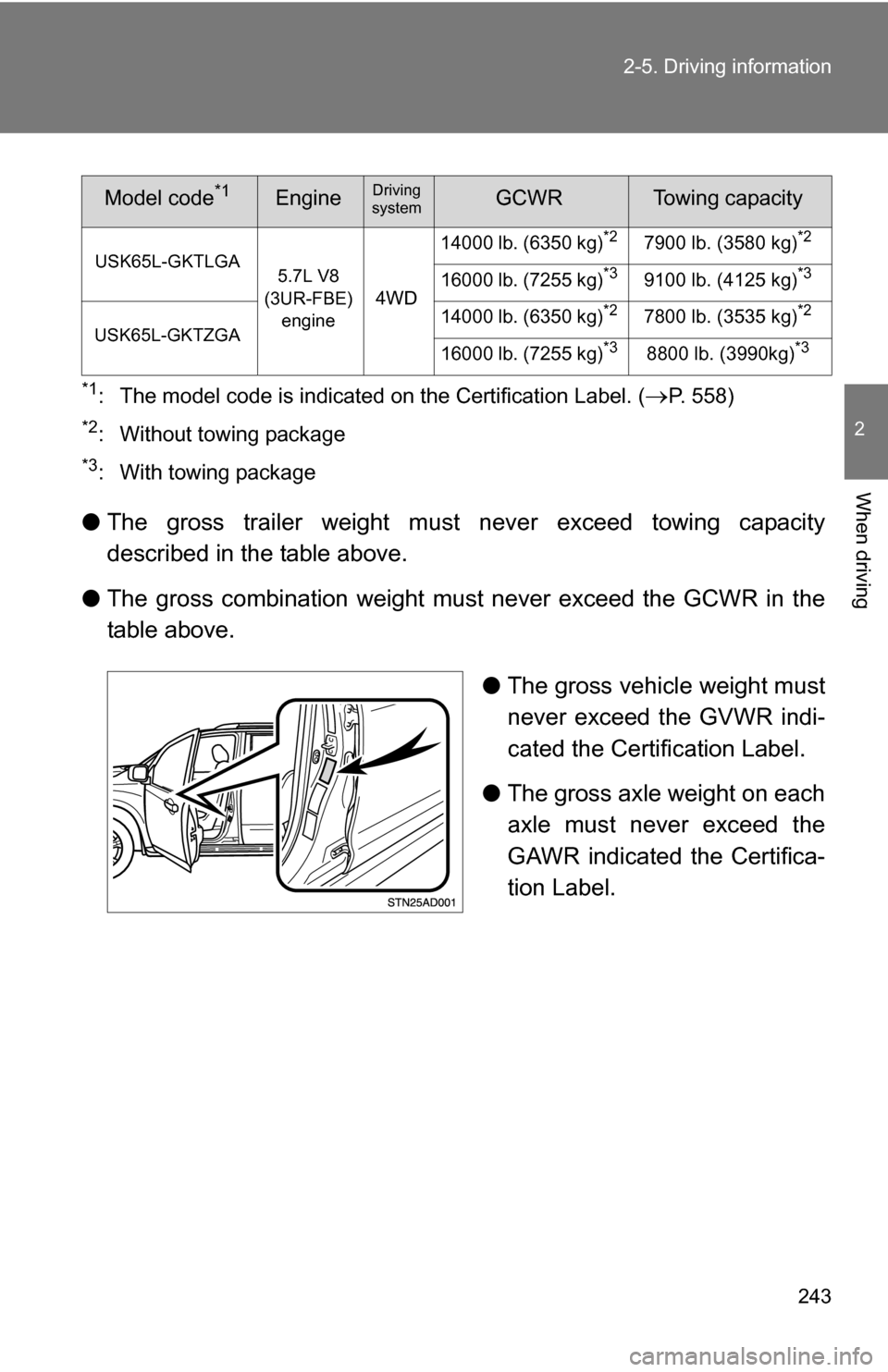
243
2-5. Driving information
2
When driving
*1: The model code is indicated on the Certification Label. (P. 558)
*2: Without towing package
*3: With towing package
●
The gross trailer weight must never exceed towing capacity
described in the table above.
● The gross combination weight must never exceed the GCWR in the
table above.
●The gross vehicle weight must
never exceed the GVWR indi-
cated the Certification Label.
● The gross axle weight on each
axle must never exceed the
GAWR indicated the Certifica-
tion Label.
Model code*1EngineDriving
systemGCWRTowing capacity
USK65L-GKTLGA 5.7L V8
(3UR-FBE) engine
4WD 14000 lb. (6350 kg)
*27900 lb. (3580 kg)*2
16000 lb. (7255 kg)*39100 lb. (4125 kg)*3
USK65L-GKTZGA14000 lb. (6350 kg)*27800 lb. (3535 kg)*2
16000 lb. (7255 kg)*38800 lb. (3990kg)*3
Page 244 of 612
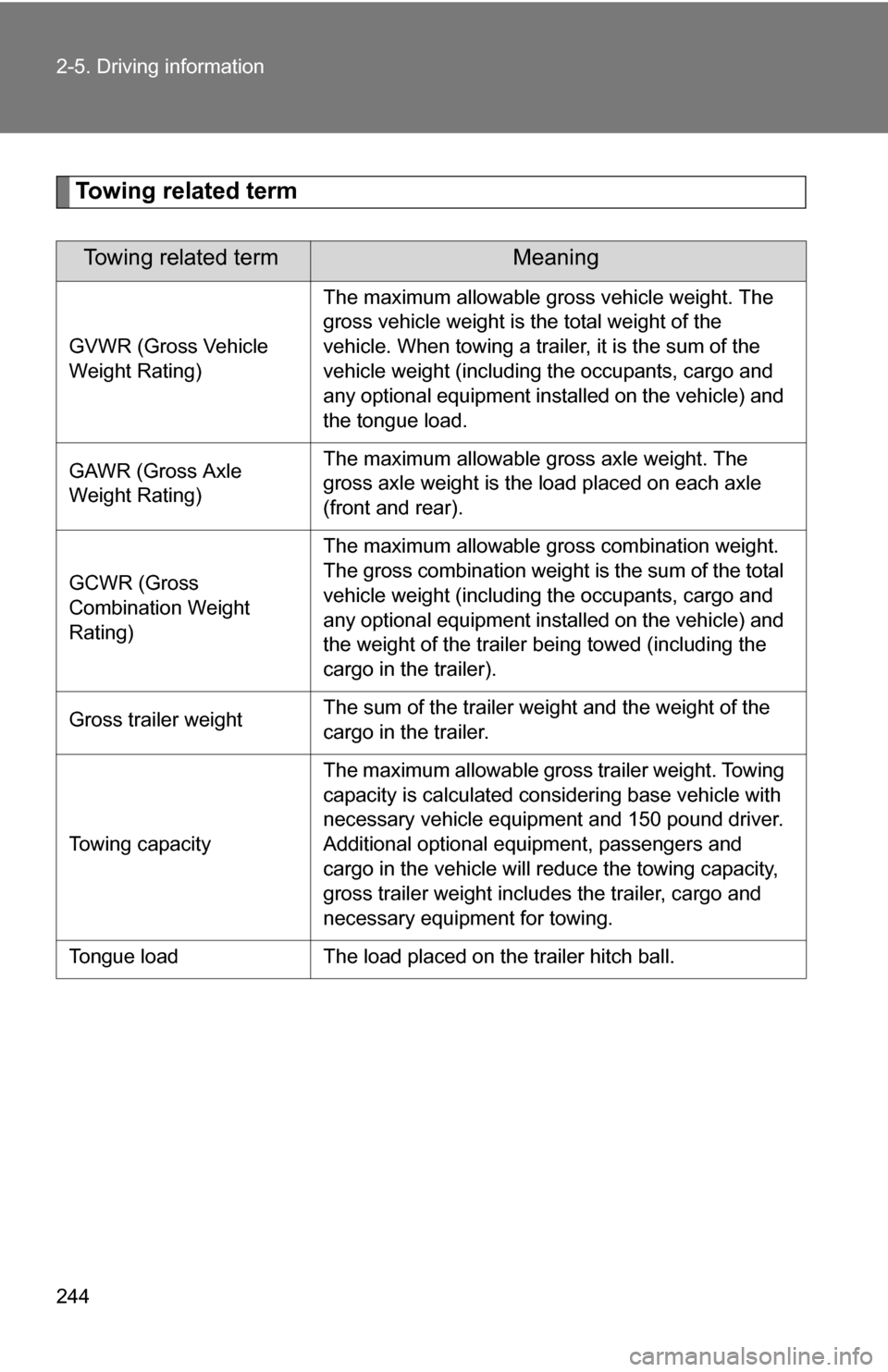
244 2-5. Driving information
Towing related term
Towing related termMeaning
GVWR (Gross Vehicle
Weight Rating)
The maximum allowable gross vehicle weight. The
gross vehicle weight is the total weight of the
vehicle. When towing a trailer, it is the sum of the
vehicle weight (including the occupants, cargo and
any optional equipment installed on the vehicle) and
the tongue load.
GAWR (Gross Axle
Weight Rating)The maximum allowable gross axle weight. The
gross axle weight is the load placed on each axle
(front and rear).
GCWR (Gross
Combination Weight
Rating)
The maximum allowable gross combination weight.
The gross combination weight is the sum of the total
vehicle weight (including the occupants, cargo and
any optional equipment installed on the vehicle) and
the weight of the trailer being towed (including the
cargo in the trailer).
Gross trailer weightThe sum of the trailer weight and the weight of the
cargo in the trailer.
Towing capacity
The maximum allowable gross trailer weight. Towing
capacity is calculated considering base vehicle with
necessary vehicle equipment and 150 pound driver.
Additional optional equipment, passengers and
cargo in the vehicle will reduce the towing capacity,
gross trailer weight includes the trailer, cargo and
necessary equipment for towing.
Tongue loadThe load placed on the trailer hitch ball.
Page 245 of 612
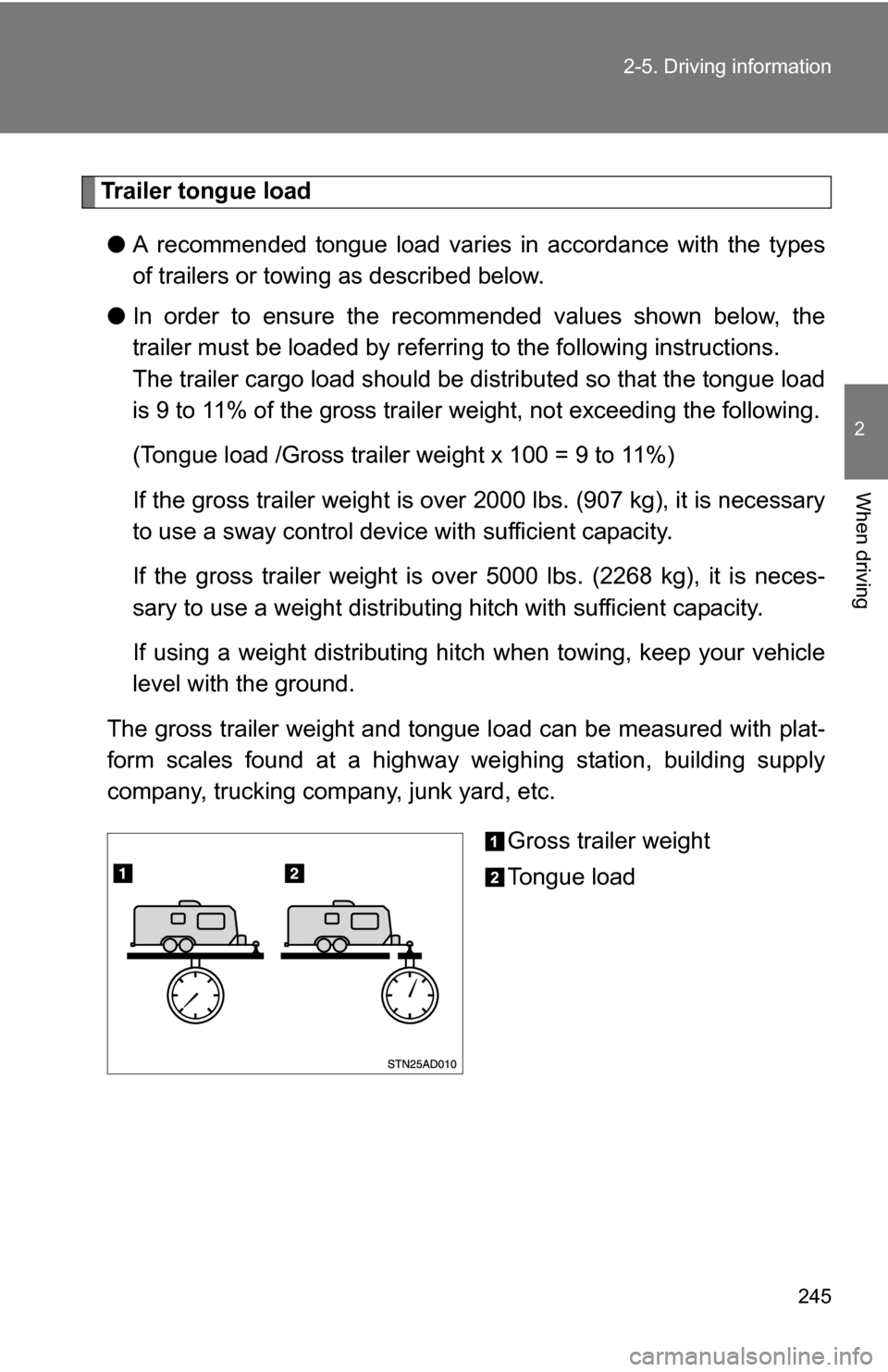
245
2-5. Driving information
2
When driving
Trailer tongue load
● A recommended tongue load varies in accordance with the types
of trailers or towing as described below.
● In order to ensure the recommended values shown below, the
trailer must be loaded by referring to the following instructions.
The trailer cargo load should be di stributed so that the tongue load
is 9 to 11% of the gross trailer weight, not exceeding the following.
(Tongue load /Gross trailer weight x 100 = 9 to 11%)
If the gross trailer weight is over 2000 lbs. (907 kg), it is necessary
to use a sway control device with sufficient capacity.
If the gross trailer weight is over 5000 lbs. (2268 kg), it is neces-
sary to use a weight distributing hitch with sufficient capacity.
If using a weight distributing hitch when towing, keep your vehicle
level with the ground.
The gross trailer weight and tongue l oad can be measured with plat-
form scales found at a highway weighing station, building supply
company, trucking company, junk yard, etc.
Gross trailer weight
Tongue load
Page 246 of 612
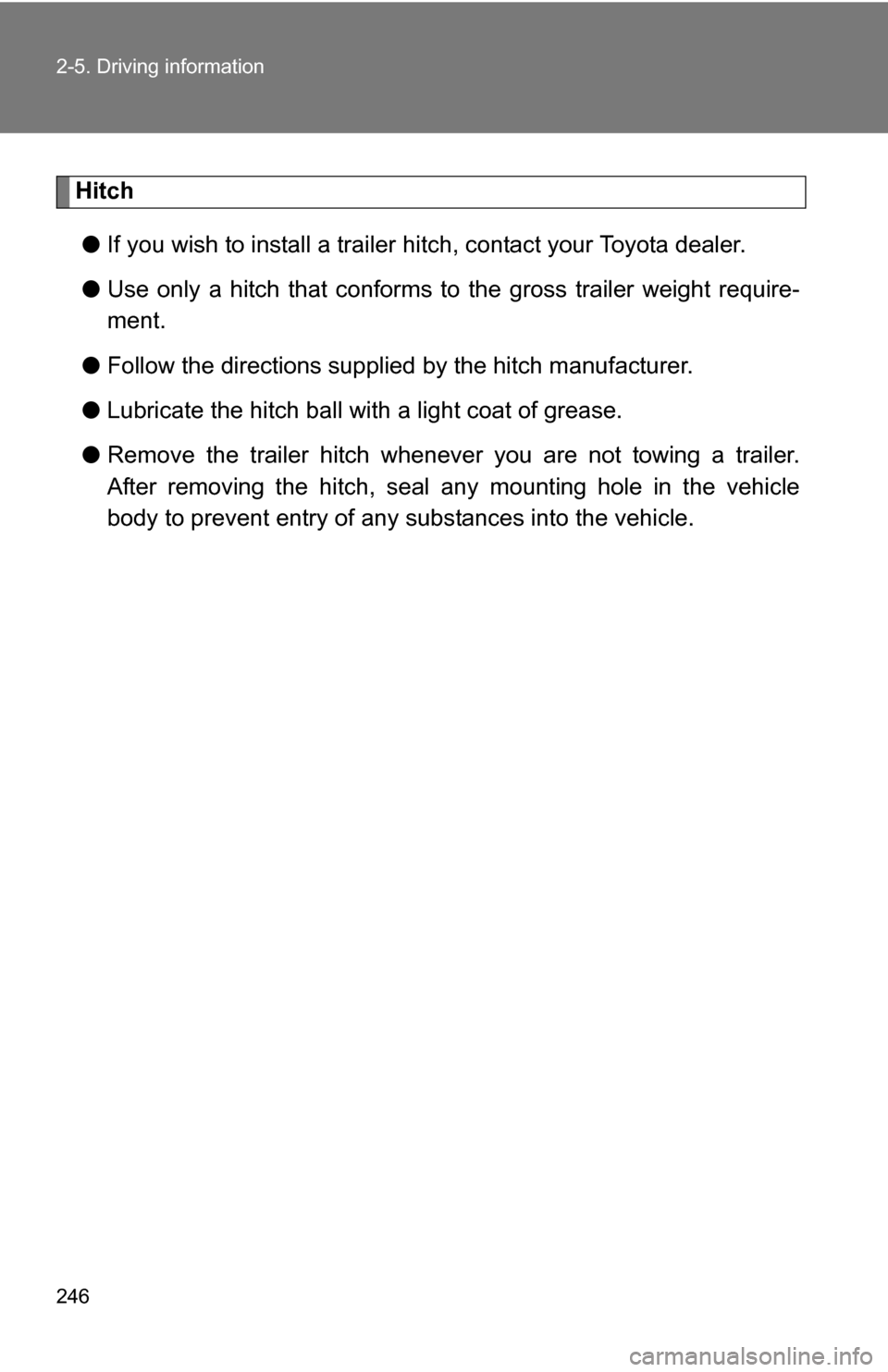
246 2-5. Driving information
Hitch● If you wish to install a trailer hitch, contact your Toyota dealer.
● Use only a hitch that c onforms to the gross trailer weight require-
ment.
● Follow the directions supplied by the hitch manufacturer.
● Lubricate the hitch ball with a light coat of grease.
● Remove the trailer hitch whenever you are not towing a trailer.
After removing the hitch, seal any mounting hole in the vehicle
body to prevent entry of any substances into the vehicle.
Page 247 of 612
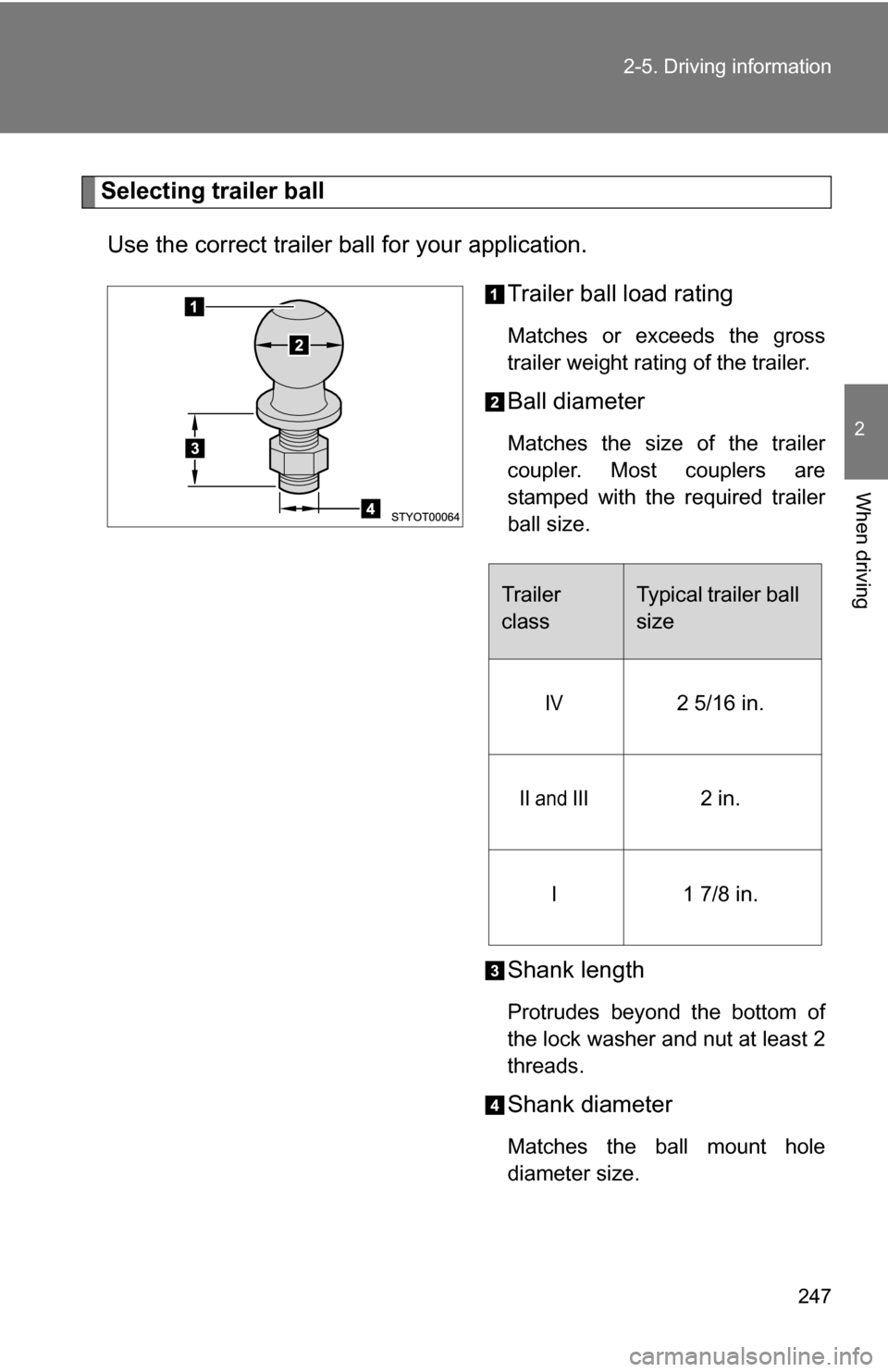
247
2-5. Driving information
2
When driving
Selecting trailer ball
Use the correct trailer ball for your application. Trailer ball load rating
Matches or exceeds the gross
trailer weight rating of the trailer.
Ball diameter
Matches the size of the trailer
coupler. Most couplers are
stamped with the required trailer
ball size.
Shank length
Protrudes beyond the bottom of
the lock washer and nut at least 2
threads.
Shank diameter
Matches the ball mount hole
diameter size.
Trailer
classTypical trailer ball
size
IV2 5/16 in.
II and III2 in.
I1 7/8 in.
Page 248 of 612
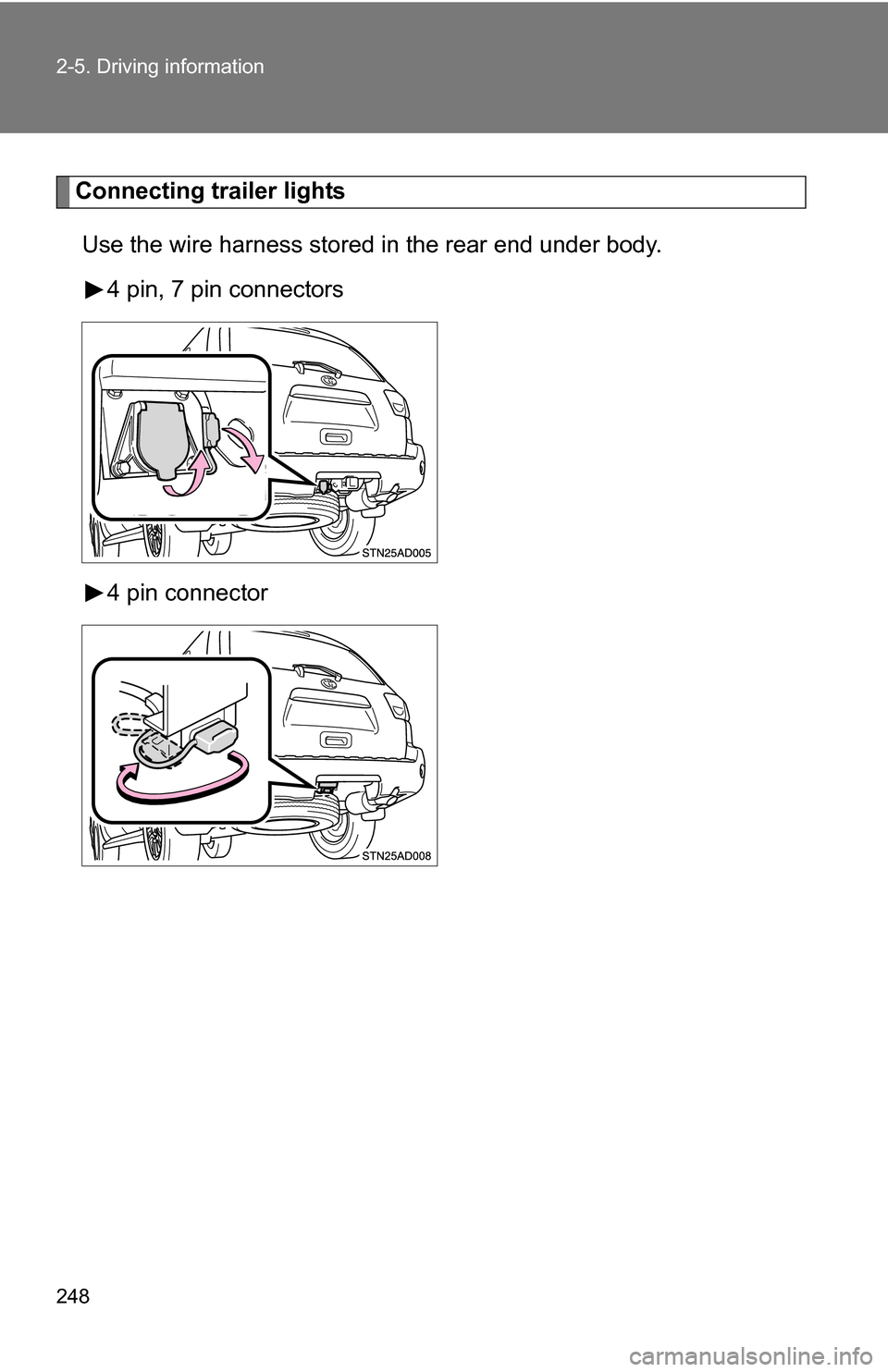
248 2-5. Driving information
Connecting trailer lightsUse the wire harness stored in the rear end under body. 4 pin, 7 pin connectors
4 pin connector
Page 249 of 612

249
2-5. Driving information
2
When driving
Trailer towing tips
Your vehicle will handle differently when towing a trailer. The three
main causes of vehicle-trailer ac cidents are driver error, excessive
speed and improper trailer loading. Keep the following in mind when
towing.
● Speed limits for towing a trailer vary by state or province. Do not
exceed the posted towing speed limit.
● Before starting out, check the trailer’s light and the vehicle-trailer
connections. Recheck after driving a short distance.
● Practice turning, stopping and reve rsing with the trailer attached in
an area away from traffic until you become accustomed to the feel
of the vehicle.
● Reversing with a trailer attached is difficult and requires practice.
Grip the bottom of the steering wheel and move your hand to the
left to move the trailer to the left. Move your hand to the right to
move the trailer to the right. (Thi s is generally opposite to reversing
without a trailer attached.) Avoid sharp or prolonged turning. Have
someone guide you when reversing to reduce the risk of an acci-
dent.
● As stopping distance is increased when towing a trailer, vehicle-to-
vehicle distance should be increased. For each 10 mph (16 km/h)
of speed, allow at least o ne vehicle and trailer length.
● Avoid sudden braking as you may skid, resulting in jackknifing and
loss of control. This is especiall y true on wet or slippery surfaces.
● Avoid jerky starts or sudden acceleration.
● Avoid jerky steering and sharp turns, and slow down before mak-
ing a turn.
● Note that when making a turn, th e trailer wheels will be closer than
the vehicle wheels to the inside of the turn. Compensate by making
a larger than normal turning radius.
Page 250 of 612
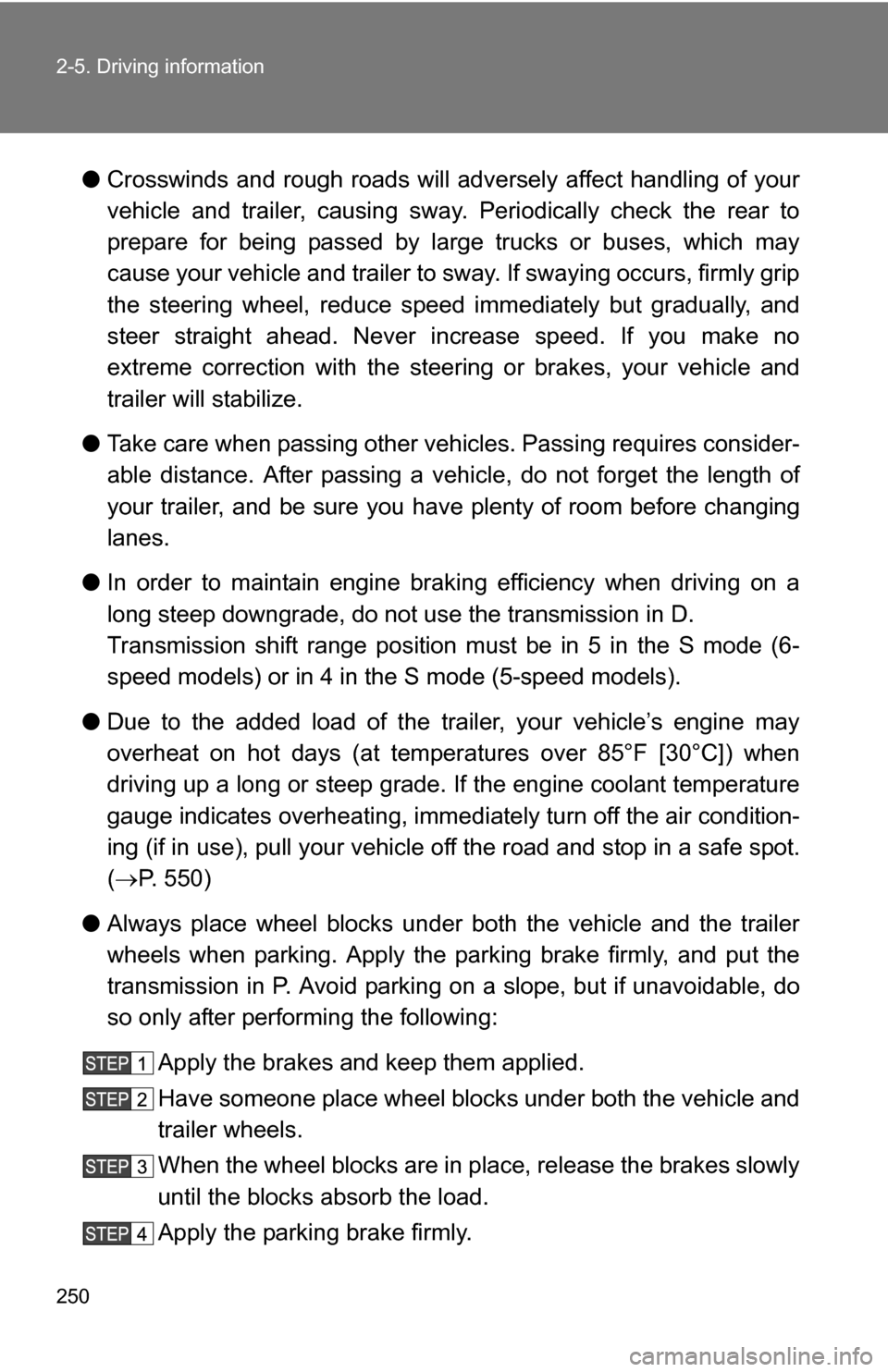
250 2-5. Driving information
●Crosswinds and rough roads will adversely affect handling of your
vehicle and trailer, causing sway . Periodically check the rear to
prepare for being passed by large trucks or buses, which may
cause your vehicle and trailer to sway. If swaying occurs, firmly grip
the steering wheel, reduce speed immediately but gradually, and
steer straight ahead. Never increase speed. If you make no
extreme correction with the stee ring or brakes, your vehicle and
trailer will stabilize.
● Take care when passing other v ehicles. Passing requires consider-
able distance. After passing a vehi cle, do not forget the length of
your trailer, and be sure you hav e plenty of room before changing
lanes.
● In order to maintain engine braking efficiency when driving on a
long steep downgrade, do not use the transmission in D.
Transmission shift range position must be in 5 in the S mode (6-
speed models) or in 4 in the S mode (5-speed models).
● Due to the added load of the trailer, your vehicle’s engine may
overheat on hot days (at temper atures over 85°F [30°C]) when
driving up a long or steep grade. If the engine coolant temperature
gauge indicates overheating, immediately turn off the air condition-
ing (if in use), pull your vehicle off the road and stop in a safe spot.
( P. 550)
● Always place wheel blocks under both the vehicle and the trailer
wheels when parking. Apply the parking brake firmly, and put the
transmission in P. Avoid parking on a slope, but if unavoidable, do
so only after performing the following:
Apply the brakes and keep them applied.
Have someone place wheel bloc ks under both the vehicle and
trailer wheels.
When the wheel blocks are in place, release the brakes slowly
until the blocks absorb the load.
Apply the parking brake firmly.